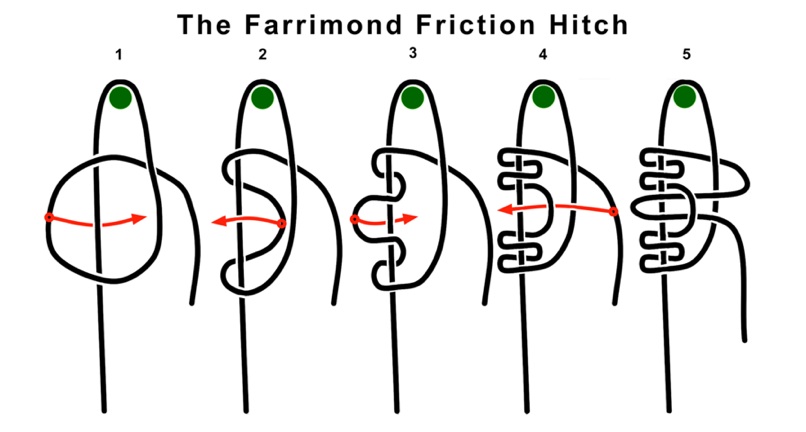Farrimond Friction Hitch on:
[Wikipedia]
[Google]
[Amazon]
The Farrimond friction hitch is a quick release adjustable

The Farrimond
at Animated Knots
Barry Farrimond's webpage
Hitch knots Knots of modern origin {{knot-stub
friction hitch
A friction hitch is a kind of knot used to attach one rope to another in a way that is easily adjusted. These knots are commonly used in climbing as part of single-rope technique, doubled-rope technique and as "ratchets" to capture progress on a ...
for use on lines under tension. It is useful when the length of a line will need to be periodically adjusted in order to maintain or adjust tension whilst remaining quick and easy to untie; such as when hanging the ridge line for a Basha. It can be used in very effective conjunction with the Siberian hitch
The Siberian hitch (or Evenk knot) is a hitch knot used to attach a rope to an object. It is a type of Bight (knot)#Slipped knot, slipped figure-eight knot, figure-eight noose. The hitch is known for having a tying method suitable even while wea ...
for this purpose. It can also be used as a mooring knot.
History
The first known presentation of thisknot
A knot is an intentional complication in cordage which may be practical or decorative, or both. Practical knots are classified by function, including hitches, bends, loop knots, and splices: a ''hitch'' fastens a rope to another object; a ' ...
was made by British actor Barry Farrimond MBE in 2008 during a demonstration at the Yellow Wood Bush Camp, Wales.
Tying
The diagram below is shown from a birds eye perspective with the green dot representing a fixed point such as a tree or post which a ridge line might be attached to. After passing the working end around the back of this fixed point, create a loop that is then placed on top of the ridge line as in fig 1. Once this has been done take the loop and wrap it around the ridge line (following the directions shown by the red arrows) until you reach fig 4. Next take the working end of the rope and create abight
The word is derived from Old English ''byht'' (“bend, angle, corner; bay, bight”). In modern English, bight may refer to:
* Bight (geography), recess of a coast, bay, or other curved feature
* Bight (knot), a curved section, slack part, or loo ...
in it. Follow the red arrow in fig 4 which shows the bight being passed under and through the hoop of rope to form the knot's quick release mechanism. Once the knot has been tightened up it should be able to resist considerable load on the ridge line whilst remaining easy to adjust and quick to release.

See also
*List of friction hitch knots
A friction hitch is a kind of knot used to attach one rope to another in a way that is easily adjusted. These knots are commonly used in climbing as part of single-rope technique, doubled-rope technique and as "ratchets" to capture progress on a ...
*List of knots
This list of knots includes many alternative names for common knots and lashings. Knot names have evolved over time, and there are many conflicting or confusing naming issues. The overhand knot, for example, is also known as the thumb knot. The ...
*Prusik
A Prusik ( ) is a friction hitch or knot used to attach a loop of cord around a rope, applied in climbing, canyoneering, mountaineering, caving, rope rescue, ziplining, and by arborists. The term Prusik is a name for both the loops of cord used ...
*Siberian hitch
The Siberian hitch (or Evenk knot) is a hitch knot used to attach a rope to an object. It is a type of Bight (knot)#Slipped knot, slipped figure-eight knot, figure-eight noose. The hitch is known for having a tying method suitable even while wea ...
References
External links
The Farrimond
at Animated Knots
Barry Farrimond's webpage
Hitch knots Knots of modern origin {{knot-stub